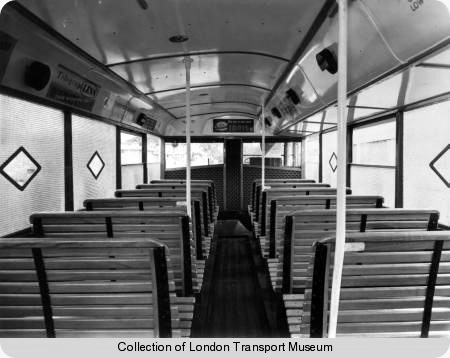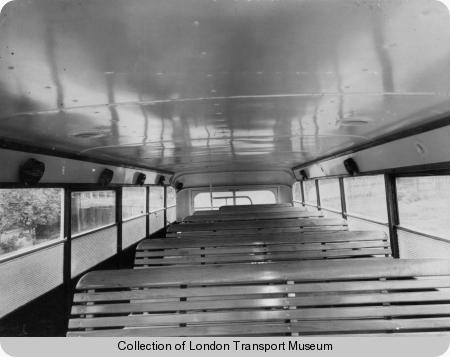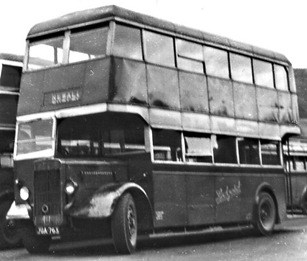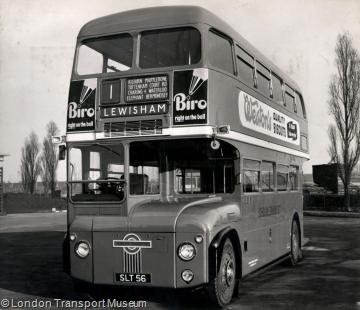London Transport – Daimler CWA6 – GXE 578 – D 1
London Transport
1944
Daimler CWA6
Duple L27/26R
Daimler CWA6’s D1 to D6 were delivered to Merton Garage in April-May 1944. They had Duple lowbridge bodies which supplemented the austerity STL bodies which had been fitted onto spare STL chassis in 1942/43. There was still a shortage for the 127 route (Merton-South Wimbledon) hence the delivery of the Daimlers. They displaced some lowbridge ST’s from Watford and other lowbridge buses from Godstone which somehow had kept the service going. These, together with D’s 128-131 delivered in late 1945, plodded the same semi-circular 9 mile furrow to termini only 2 miles from each other! Sometimes, for a treat, they’d be allowed out on the long haul from Morden Station to Epsom for the races (a riding treat for me, too) and sometimes to historic Hampton Court on route 152. They all ended their short lives at the end of 1952, some going to Ceylon, along with some of their big brothers!.
The photographs show front/back views and interior views. The lowbridge layout was conventional for the period, with rows of four seats, without staggering, and an offside sunken gangway, which intruded slightly into the driver’s cab.
I mentioned a while ago the highly-varnished wooden slated seats and the tendency for upstairs passengers to suffer from ‘lateral instability’ around corners! Upholstered seats did not come until around 1948/49, from memory. The position of the rear number plate was unusual on these vehicles, for many austerity buses had them fitted above the window on the nearside rear bulkhead (above the used ticket box), making them invisible from the street! LT soon put them by the offside rear lights as per usual.
It is nice to see photos of one of them in virgin condition, unspoiled by adverts, particularly on the rear upper panel.
My thanks to London Transport Museum for the use of the above shots.
A full list of Daimler codes can be seen here.
Bus tickets issued by this operator can be viewed here.
Photograph and Copy contributed by Chris Hebbron
Thank you Chris for a most interesting account of this particular batch of "utility" vehicles. Dreadful though WW2 undeniably was, it necessitated the design and construction of some most characterful buses, many variations of which I was privileged to travel and to work on. These included Daimler CWA6/CWD6, Guy Arab and Bristol K6A – with bodies by Duple, Roe, Park Royal, Pickering to name but a few. Despite the poor materials which blighted many of these vehicles they performed a heroic service, many having long and distinguished careers even into the 1960s. My close associates often sigh, good naturedly I think and hope, at my hero worship of these historic buses – especially the one hundred "Sutton HGFs" D182 – 281, even though they were to relaxed specification and were delivered in 1946 they were still commendable and fascinating "utilities" as far as I’m concerned.
Chris Youhill
I agree, Chris, that the vehicles had character and even simplicity, plainness if you like, has a certain attractiveness, if you understand my meaning. What always amazed me was, that in the situation of total war, each body builder was permitted to design its own style within the ‘utility’ specification laid down. Fascinating from a bus enthusiast’s point of view, but a wasteful duplication of manpower! As for the Sutton Daimlers, the one aesthetic let-down was the rear three-piece destination display, which looked as if it had been a last-minute pop-riveted afterthought and in perpetual risk of falling off! It probably was, and was!
A further look at D1’s lean-back, but ramrod straight front, above, makes me recall the frontal look of the very rare 1932 Birch body. I have seen a photo of one somewhere and will try to find and upload it.
Chris Hebbron
As you rightly say, Chris, the variations in designs within the "utility" specification were fascinating. The first two Duples that we had at Samuel Ledgard’s, also in 1944, were the exact highbridge equivalent of D1. I think that the slightly later Duple bodies were possibly the most handsome and smoothest of line of the real "utilities", and surely the Pickering offering from the North East must have been the most ghastly in appearance and poor construction. I quite agree that the ludicrous rear destination assembly on the 1946 "HGFs" was unforgiveable – and all to inform would be passengers in great detail which bus they had missed!! In all twenty two of the Ledgard vehicles these abominations were removed and immaculately panelled over before entering service. Seven of the batch were also fitted with platform doors and emergency exits of the most professional appearance. Stop me now before I go on for pages about a most intriguing series of buses !!
Chris Youhill
I suppose these are tram seats, but trams don’t roll! The question is indeed "why bother?" when there is a limit to what you can save. The interiors are still lined: but there are no headlamps & only one (two?) drain out of the upper deck needing a moulding to keep the contents off the platform: & it is fixed together a bit like a Leyland National (! for the same reasons?)- fair enough but not shattering: I suppose then it was a departure from traditional coach building….. but two questions: what is in the windows & is that just a void round the radiator? You presumably didn’t need to follow the old custom of leaving the engine access open in hot weather! I have never seen an "original" utility bus, so these photos are helpful.
Joe
Hi Joe. It’s true that wooden latted seats were widely used on trams, but I guess their construction was cheaper, simpler and lent itself more to mass production than upholstered seats. I can certainly remember them on utility trolleybuses of Nottingham City Transport. Same goes for the rear dome construction which was produced from flat metal sections, so that formation of complex curves was not necessary. Many of the features were intended to reduce the production man-hours needed as well as the costs. Actually the bus does have headlights, but they are small and fitted with blackout cowels giving only a very feeble light beam ahead. You will notice that the interior lights are also dimmed with a blue cover. The windows (in London at least) were encased in a close weave netting to prevent splintering in case of bomb blasts nearby. This let the light in but made the windows opaque – hence the small diamonds of clear glass in the centre. The use of white handrails (also white tips to the mudguards and probably the white spot on the rear) were intended as an aid to sight during the blackout.
Stephen Ford
The slatted seats were new, made for these buses., but upstairs tram seats could be wooden, but were constructed to have reversible backs.
Trams DO roll, Joe, or, in fact, corkscrew, especially if they ran only on four wheels and not trucks (on trains called bogies). The action was very strange and conducive to small children throwing up!
It is not clear from the photos, but the design of austerity bus bodies ensured that they could be built with unskilled labour. The bodywork had no curves worth mentioning, obviating panel-beating (look at the rear of the roof, called lobster–style which was flat steel cut then curved round at the end and just welded). They only had single skins (so you could see the body ribs inside, and only single-skin roofs (sometimes the ribs were inside, sometimes outside), but, worst of all, they were generally built with steel sheeting and unseasoned wood of uncertain origin (ash was the usual pre-war wood used) ensuring rust problems and the wood framing literally turning to dust after around seven years. Even then, some bodybuilders had their pride and rejected some of the totally unsuitable wood they were given to work with! London Transport started a programme of re-building the bodies around 1948/9 and gave up halfway through, because of the time and expense. Although hard to see, the bus does have headlights, very tiny and black painted (the offside one is below the cab vent). There is no void around the radiator, there was a chicken-style wire grill inside the steel radiator framework. The engine had the usual side cover, which was usually in proper position on these buses and not leaning on the wing! The Daimler chassis were simplified versions of the pre-war model, but were quite robust and sophisticated. Most utility buses of the era had chassis which long outlasted the bodies. They went on until rendered obsolete more because of their out dated halfcab style and ponderous road performance in the 1960’s than for mechanical shortcomings. In their day, despite steel being used rather than aluminium, the stripped-out bodywork was usually the same weight as pre-war buses. From the above photos, you’ll see that the only touch of luxury was the patterned material covering the front downstairs bulkhead!
Finally, you mention the windows and I assume you mean the diamond shapes. This was anti-blast netting attached to the inside of the non-opening windows and lower glass of the few opening ones – two each deck! The diamond section allowed passengers to see out. The netting was not not universal throughout the UK – much depending on the risk of bombing where the bus operated.
Chris Hebbron
The white spot on the rear, Stephen, is an interesting point. It seemed unique to London Transport and I’ve seen it mentioned that it was an aid to trolleybus drivers in that they knew they could overtake a bus with a spot: to do so on one without was to court disaster!! There’s a logic to this theory, but whether it’s true……!
Chris Hebbron
The "trolleybus assistance" theory is an interesting one Chris, and feasible too, but I think that the more likely answer is that the white spots were a general aid to visibility in the WW2 blackout. I’ve had a quick look at the prewar "STLs" and there isn’t a white spot to be seen when they were nearly new, but plenty in the chapter about the War period.
Chris Youhill
I think Chris Youhill is right about the spot – but I arrived over seven years after VE and VJ days, so what do I know?
David Oldfield
Duple really were a class act weren’t they? Even with the constraints of the utility specification they managed to make them look refined in an un-fussy "Puritanical" sort of way. Even the lobster-back canopy is tidily done. And not many manufacturers bothered to put radiused windows in the rear emergency door. This really softens what might otherwise be a rather savage design. The Barton’s specimens I used to ride on were similar, but must have come a bit later, since they had upholstered seats and "peacetime" rear canopies – although of course, Barton’s did have a penchant for rebuilding, modifying and generally tinkering with their rolling stock!
Stephen Ford
London Transport never actually ordered any Duple bodies for their chassis (most, pre-war, were built by them at Chiswick, anyway). But they had inherited 50 Duple-bodied Green Line coaches from LGOC, so had some experience and Duple was third on their preferred list of body suppliers in the war, maybe because they were a London company (Park Royal, I suspect, was first)! They had a good reputation, pre-war, too. When they required another three lowbridge Daimlers for the same 127 route above, delivered in November 1945, they’d managed to wangle Duple to be the bodybuilders again, even though Massey were the only firm making such bodies by then! Apart from the aforesaid 7 D’s, there were a further 104 highbridge ones, 20 B’s (Bristols) and a solitary G (Guy)!
As an aside, Chris Youhill commented on the ugliness and flimsiness of Pickering austerity bodies – has anyone got a photo of one of them they could upload, assuming the bodies lasted long enough for a photo opportunity!
Chris Hebbron
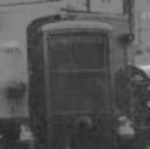 Thanks for all the feedback. I’ve found the headlamps and realised that the top deck ceiling is the roof (like Midland Red?): the white circle is clearly the thing to aim your single ( ie dipped) headlamp at in the smog: and smog it would have been upstairs with one side window….. but I’m still baffled why the body doesn’t touch the radiator (?): and was the Leyland National the natural heir of this construction system?
Thanks for all the feedback. I’ve found the headlamps and realised that the top deck ceiling is the roof (like Midland Red?): the white circle is clearly the thing to aim your single ( ie dipped) headlamp at in the smog: and smog it would have been upstairs with one side window….. but I’m still baffled why the body doesn’t touch the radiator (?): and was the Leyland National the natural heir of this construction system?
Joe
In reply to Chris Hebbron’s latest message, could you please if possible include this picture of Samuel Ledgard Otley depot Pickering bodied JUA 763. Its a good illustration of how ghastly, inexcusable even under the Fheurer’s tyranny, the Pickering offerings were.
Chris Youhill
The discussion about wooden seats was interesting. I believe that Aberdare Corporation until quite modern times specified wooden seats because they carried a lot of coal miners who would have probably soiled moquette seating. Also the now defunct operator Jolly of South Hylton in County Durham had a batch of bus bodied Duple Dominants and they had a rear wooden seat to counteract vandalism.
Philip Carlton
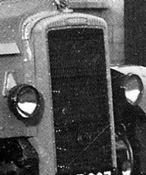 I can answer the Daimler radiator mystery, Joe. As with many buses with radiators, the gap between radiator and body was filled by some sort of rubber composite material to keep damp and dirt out. When the D’s were re-painted and overhauled, the radiators and seals were changed from black to red, as my photo demonstrates. One oddity about this photo is that it is the only D I’ve ever seen with mansized headlamps and looking the better for it!.
I can answer the Daimler radiator mystery, Joe. As with many buses with radiators, the gap between radiator and body was filled by some sort of rubber composite material to keep damp and dirt out. When the D’s were re-painted and overhauled, the radiators and seals were changed from black to red, as my photo demonstrates. One oddity about this photo is that it is the only D I’ve ever seen with mansized headlamps and looking the better for it!.
Chris Hebbron
Thanks, Chris, for letting me and others see the Pickering offering. The product could have done little to lift morale and possibly even lowered it! Mind you, I’ve seen photos of the enemy’s efforts with Berlin’s double deckers in the inter-war years and they weren’t far removed from the style of the Karrier CL6 body I published here some months ago!
I assume the Ledgard bus is a Guy Arab II, but it certainly hasn’t got Guy’s extended front wings, certainly not the nearside one, anyway. Intriguing.
Chris Hebbron
I know what you mean about the Pickering, but I guess in the war beggars couldn’t be choosers. And, as a colleague used to say, when you’re tired after work a third class ride beats a first class walk any day! For much of the duration the last buses in many cities ran at 9.00 (to save fuel and maybe let crews get home before the bombs started falling in earnest). Late workers in essential industries had passes allowing them to jump the (long) queues which didn’t stand a chance of all fitting on these last buses.
Stephen Ford
Not heard that saying before, Stephen, but my son used to say (in relation to the crude but successful Russian T34 tank in WWII) ‘Quantity has a quality of its own" which equally applies to these wartime saviours and stalwarts. And it the dark days of the war, 1942-43, there was an edict to save a further 25% on fuel and tyres. This is when bus companies ran buses into cities in the morning rush-hour, where they remained parked until returning to the suburbs in the evening. Drivers and conductors took the remaining buses home, then taking up duty again for the return journey. In London, there were rows and rows of them all over Central London, even in the Royal Parks.
Chris Hebbron
Chris H is quite right in assuming that the Guy JUA 763 was an Arab 11 and its missing outswept mudguard – from time to time – was a source of mystery. Of course we could have asked at the time I suppose but didn’t. Incredibly however the elusive elegant fitting suddenly appeared years later on ex United Bristol K GHN 840 – which made that vehicle look as odd so equipped as the Guy did having lost it !!
Chris Youhill
Thanks for the radiator pic, Chris- yes I now see the shrouding on the original: examples I have seen in the early 60’s were leather & looked very naff. The cleaned up painted version is very smart & neat- notice too the neat bracket added for the jumbo headlamp. What does the badge say? LT?
Joe
Chris Y – Thx for the ‘wing’ story – it’s amazing what engineers put away for a rainy day, just in case! And, in connexion with Pickering’s unattractiveness, I always felt that LT’s least attractive recipient was the Massey version. BTW – Where was Pickering’s factory?
Joe – The badge said ‘London Transport’ and was never that secure on these radiators, which weren’t designed to take anything; a fluted radiator top was considered enough for Daimler cars and buses! Interestingly, I notice that D1 above has not yet been fitted with the plate. I suspect it is still at Chiswick, where it would have been delivered to. The Green Line D’s never bore them and the Guys seemed to be 50/50. Amazing that time was wasted on such frills in a time of National Emergency!
Chris Hebbron
How fascinating to read about D1-6.
They seem identical to the Bradford ones which I remember well, including the Upper Deck "lateral instability". The photo brings it all back!!
In Bradford, these buses were regarded with total disrespect, being nicknamed "pig troughs" or "Flat Harriets", but they always appealed to me, being a utility admirer.
Duple bodies were probably amongst the best, as far as I can see, and were probably helped by the "V" strip against the canopy on the n/s. There was something very distinctive about the "shell back" dome which worked with, rather than against the overall look of the body, and , when "normal" domes reappeared in 1945, the body lost some of its appeal for me. Duple utility bodies could keep me going for hours. I also well remember the Ledgard ones, although memories of the HGFs seem to predominate there!
John Whitaker
Chris H – I believe the Pickering factory was at Wishaw in Scotland and will check as soon as I have chance.
Chris Youhill
Pretty sure the Pickering factory was at Wishaw. Tram literature quotes Wishaw as the place where Pickering built the Aberdeen streamliners
John Whitaker
Yes, I’m sure that the Pickering factory was in Wishaw, Lanarkshire in Scotland, from what I’ve heard and read over the years.
The Ministry of War Transport (I think that’s the correct title) was responsible for allocating both chassis and body builders to operator’s applications for new buses. The intention was that Pickerings would deliver their products to operators in Scotland and northern England. Apparently one Midlands municpallity (was it Derby?) had heard that Pickering bodies were "fragile" and refused them. As a result two Pickering-bodied Guy Arabs ended up with Brighton Hove & District on the south coast! As non-standard to that fleet, they were sold or transferred after the war (c.1948?) to Western / Southern National, where I think they operated out of Plymouth for a few years.
I believe most of Pickerings bus work pre-war went to Glasgow Corporation, and I have a vague memory that their main occupation was as a builder of railway wagons. Were they more successful in that role than in bus work?
Michael Hampton
The question about the white disc on the back of vehicles is mentioned in "London Transport in the Blitz" by Michael H C Baker. I understand that motor buses had the disc painted on the rear panel but trolleybuses were distinguished by carrying LT’s trolleybus bulls eye motif there (which was the standard bar and circle device superimposed with a ‘T’ and with the word "Trolleybus" on the bar). In later years the trolleybus motif was moved to the rear window to permit the rear panel to be used for advertising.
Trevor Haynes
Thanks for your comment, Michael. What Michael Baker wrote is my understanding of the situation. I’ve never heard of or read the book, incidentally, but must try and get a copy now! The ‘T’ motif was not a war characteristic, unlike the white disc Strangely, however, overhauled buses were still leaving Chiswick with the disc painted, for some months after VE Day.
Chris Hebbron
22/10/11 – 17:36
I’ve just found your website/blog/W.H.Y. and of course find it fascinating. Some of you chaps have great depth of knowledge – and these forums can only increase it, I guess!
I have a few pics taken as a spotterlad and if I can find a way to do it, I’ll attach a shot of ex-L.T. D74 working in Leicestershire for Brown’s Blue of Markfield, which firm I believe ferried coal miners of the region to their daily toil. BB had as I recall, D 19, 161, 165, 169, 179 and 74 and may have had at least one ex-East Kent Daimler, too.
OK now I’ve found the advice on how to forward photos, so I’ll get on with it!
Victor Brumby
24/10/11 – 17:39
When my interest in `Bus Spotting` started, in the early 1950’s, our local service was route 151 that included Morden Station and Reynolds Close, Hackbridge. My lasting memory is the service used D models. At our local stop (we called it The Circle at Carshalton) we did however prefer to wait for the new RT to return from Reynolds Close to ride on the newer bus to Morden. In what I have read recently it seems the D’s did not run route 151 as my aging memory thinks. Is it possible the D’s were only `loaned` to route 151 at times? If not, can anyone tell me what type of bus was on route 151 before RT’s took over?
Derek Hanlon
25/10/11 – 07:14
Your memory is not at fault, Derek. The original 151 route started in 1949, running from Morden Stn to Hackbridge. Vehicles were supplied solely from Sutton Garage, which, at this time, had an entire allocation of 100 ‘relaxed’ style D’s in the D182-281 series. The last of the D’s went in 1954, replaced by RT’s.
I lived in Morden until 1956 and only recall D’s on the route, although I remember seeing earlier D’s on there once or twice, presumably on loan from nearby Merton Garage.
Chris Hebbron
26/10/11 – 05:44
Thanks for that Chris. Its nice to have confirmation that the old memory still works. Having now found your (extremely good and worthwhile) site I expect I shall have a few more requests sometime. Thanks.
Derek Hanlon
01/08/13 – 06:46
I have only recently found this site and have Noticed that two of the people who use the site Chris Hebbron and Chris Youhill remember the Daimlers from Sutton and Merton Garages. Before I went into the R.A.F. in 1953 I was a Garage Youth at Sutton garage, basically a Junior Mechanic. At the time we not only had the Daimlers but also the single deck A.E.C Renown buses known as Scooters. On Saturdays we borrowed single deck vehicles from other garages, one of which was Sidcup to supplement our service 213 to Kingston. The Scooters were replaced by the R.F. Although we boys were not allowed to drive round the garage we were often asked by the mechanics to move buses, so we did and to get different types such as Qs and 10t10s was a bonus. Like other contributors I loved the Daimlers and disappointed that most went to Ceylon and none were preserved. With regards to the route 151. I later drove from Merton Garage and the 151 was one of my regular routes, but with an R.T. It is correct that Sutton, in the 1950s did run that route. I hope this is of some interest.
Brian Blackburn
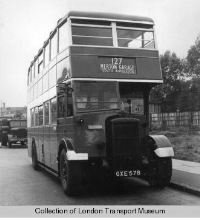 Vehicle reminder shot for this posting
Vehicle reminder shot for this posting
31/01/14 – 13:10
The white spot controversy!
Definitely only motor buses carried it, both double deck and single deck. The theory about trolleybus drivers being able to understand that they could overtake a white spot motor bus is reinforced by the fact that the Trolleybus symbol was moved from the lower rear panel to the rear lower saloon window during the war (not afterwards) from its previous position. This had nothing to do with lower panel advertising as suggested, as pre-war the symbol was very low down on the left and there was plenty of room for advertising above it and many trolleys had such advertising pre war. The adverts that were missing pre war on trolleys were those either side of the destination blinds between decks but why this was so seems to be a complete mystery as they were fitted post war with no problem.
Gordon Mackley
Quick links to the - Comments Page - Contact Page - Home Page

